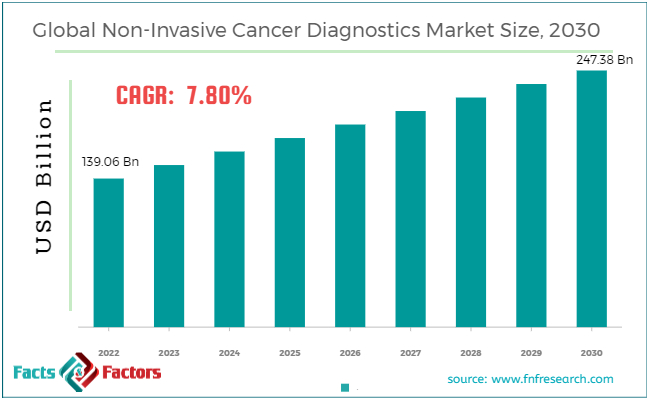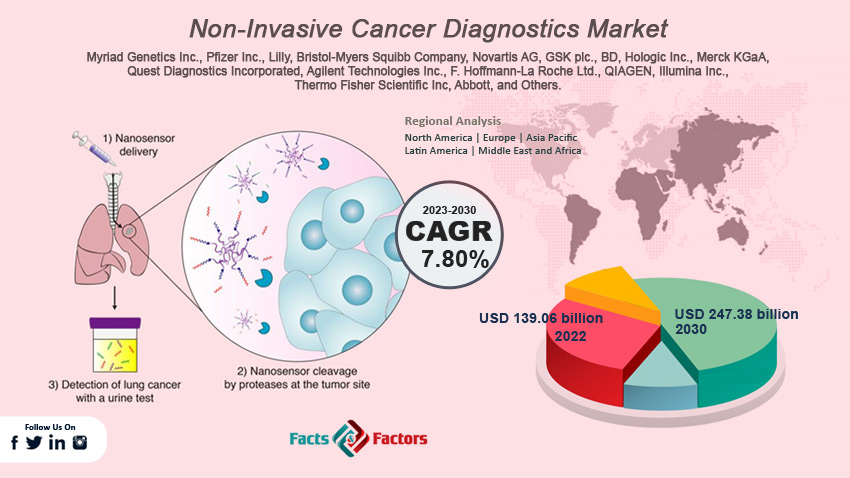Search Market Research Report
Non-Invasive Cancer Diagnostics Market Size, Share Global Analysis Report, 2023 – 2030

Non-Invasive Cancer Diagnostics Market Size, Share, Growth Analysis Report By Tests (Spectroscopy, Ultrasound, X-Rays, Nuclear Medicine, CT Scans, Blood Tests, And Others), By End-User (Hospitals & Clinics, Diagnostic Centers, And Others), By Cancer Type (Colorectal Cancer, Ovarian Cancer, Blood Cancer, Solid Tumors, Breast Cancer, Lung Cancer, And Others), And By Region - Global and Regional Industry Insights, Overview, Comprehensive Analysis, Trends, Statistical Research, Market Intelligence, Historical Data and Forecast 2023 – 2030
Industry Insights
[230+ Pages Report] According to Facts and Factors, the global non-invasive cancer diagnostics market size was valued at USD 139.06 billion in 2022 and is predicted to surpass USD 247.38 billion by the end of 2030. The non-invasive cancer diagnostics industry is expected to grow by a CAGR of 7.80%.

 Market Overview
Market Overview
Non-invasive cancer diagnostic is a set of diagnostic tools that helps healthcare professionals assess and identify the presence of cancer cells in the human body without any surgery or other invasive procedures. These diagnostic tools work on the early detection and treatment response principles along with assessing the disease progression on a regular basis. The non-invasive approaches are less risky and easy for the patients. It can even be repeated more often than any other invasive methods.
 Key Insights
Key Insights
- As per the analysis shared by our research analyst, the global non-invasive cancer diagnostics market size is estimated to grow annually at a CAGR of around 7.80% over the forecast period (2023-2030).
- In terms of revenue, the global non-invasive cancer diagnostics market size was valued at around USD 139.06 billion in 2022 and is projected to reach USD 247.38 billion by 2030.
- Expanded immunization programs are driving the growth of the global non-invasive cancer diagnostics market.
- Based on the end-users, the hospital and clinic segment is growing at a high rate and is projected to dominate the global market.
- Based on the applications, the imaging tests segment is projected to swipe the largest market share.
- Based on the tests, the recombinant vector vaccine segment is expected to swipe the largest share of the market.
- Based on the types, the breast cancer segment accounts for the largest share of the global market.
- Based on the products, the immunochemistry segment accounts for the largest share of the global market.
- Based on region, North America is expected to dominate the global market during the forecast period.

 Growth Drivers
Growth Drivers
- Increasing cancer incidences are driving the growth of the global market.
The growing incidences of cancer all across the globe are boosting the demand for non-invasive and effective diagnostic tools. Nowadays, people are highly aware of the early detection and monitoring process, which in turn is expected to positively impact the growth trajectory of the global non-invasive cancer diagnostics market.
Moreover, the global emphasis on the treatment of cancer further increases the chances of positive outcomes, thereby attracting a huge pool of patients. The non-invasive diagnostic procedures like liquid biopsies and imaging tests play an important role in the early detection of cancer cells.
For instance, New Jersey Imaging Network (NJIN) took over Montclair Radiology’s outpatient radiology asset in October 2022. NJIN is a joint venture of Radnet.
 Restraints
Restraints
- Cost of diagnostic technologies is likely to hamper the growth of the global market.
The non-invasive diagnostic procedures like molecular profiling methods and advanced imaging techniques are quite expensive and, therefore, deter price-sensitive patients. This high cost limits accessibility, particularly in the underserved or less developed regions. Reimbursement policies and insurance coverage for non-invasive diagnostics tests are not very effective, which is also likely to hamper the growth trajectory of the non-invasive cancer diagnostics industry.
 Opportunities
Opportunities
- Government initiatives and funding are likely to foster growth opportunities in the global market.
Governments in several regions are increasing the funding to strengthen their healthcare infrastructure, particularly in the field of cancer care and research. The investments are helping companies to come up with diagnostic innovations, which are further expected to widen the scope of the global non-invasive cancer diagnostics market during the forecast period.
For instance, Unilabs Sweden collaborated with Subtle Medical in July 2022 to enhance the efficiency and quality of their MRI imaging.
 Challenges
Challenges
- Complex regulatory approvals are a big challenge in the global market.
The regulatory approval for new diagnostic technology is a little time-consuming and complex process. Moreover, the strict regulatory requirements further limit the market entry of many effective diagnostic technologies, which has emerged as a big challenge in the non-invasive cancer diagnostics industry.
 Segmentation Analysis
Segmentation Analysis
The global non-invasive cancer diagnostics market can be segmented into end-users, applications, tests, types, products, and regions.
By tests, the market can be segmented into spectroscopy, ultrasound, X-rays, nuclear medicine, CT scans, blood tests, and others. The imaging tests segment is likely to grow rapidly during the forecast period. Imaging tests are important in the diagnosis, staging, and treatment planning for cancer.
Moreover, the ongoing advancements in technology, like the emergence of computer tomography, positron emission tomography, magnetic resonance imaging, and others, are further contributing towards the enhanced diagnosis and characterization of cancer. The integration of these advanced technologies in the healthcare system is helping professionals to diagnose the disease faster than before, which in turn is further fostering developments in the segment.
By end user, the market can be segmented into hospitals & clinics, diagnostic centers, and others. The hospital and clinic segment accounts for the largest share of the non-invasive cancer diagnostics industry. Hospitals are the primary setting for cancer treatment and are highly accessible to a larger pool of people.
Furthermore, these clinics and hospitals are well equipped with advanced settings that initiate non-invasive diagnostic procedures like biomarker analysis, liquid biopsy, and other imaging tests. Cancer management involves a multidisciplinary approach with inputs from pathologists, radiologists, oncologists, and other specialists. Therefore, hospitals and clinics facilitate a positive environment for the comprehensive diagnosis of cancer.
Blood test monitors the circulating tumor markers which are shed into the bloodstream. These tests are a non-invasive way to check and monitor for cancer.
By cancer type, the market can be segmented into colorectal cancer, ovarian cancer, blood cancer, solid tumors, breast cancer, lung cancer, and others. Breast cancer is the fastest-growing segment in the non-invasive cancer diagnostics industry. Breast cancer is among the most common cancers affecting people globally. Its high prevalence contributes to the domination of the segment in the market.
Also, there is a strong emphasis on the early detection and treatment of breast cancer as it improves the outcome of the intervention therapy. The non-invasive diagnostics like ultrasound, mammography, and MRI further play a vital role in the diagnosis of cancer. Moreover, the increasing awareness regarding the high incidence of breast cancer is driving the demand for regular screening, thereby fostering growth in the market.
This approach is widely used in cancer diagnostics. It is often used to identify specific biomarkers related to cancer. Certain cancers are characterized by unique protein markers, which can only be detected through immunoassays. Immunochemistry methods are applicable both in the blood-based test and the tissue-based test. This versatility of the immunochemistry approach is highly adaptable for various diagnostic landscapes, and therefore, it is a popular approach in non-invasive cancer diagnostics.
 Report Scope
Report Scope
Report Attribute |
Details |
Market Size in 2022 |
USD 139.06 Billion |
Projected Market Size in 2030 |
USD 247.38 Billion |
CAGR Growth Rate |
7.80% CAGR |
Base Year |
2022 |
Forecast Years |
2023-2030 |
Key Market Players |
Myriad Genetics Inc., Pfizer Inc., Lilly, Bristol-Myers Squibb Company, Novartis AG, GSK plc., BD, Hologic Inc., Merck KGaA, Quest Diagnostics Incorporated, Agilent Technologies Inc., F. Hoffmann-La Roche Ltd., QIAGEN, Illumina Inc., Thermo Fisher Scientific Inc, Abbott, and Others. |
Key Segment |
By Tests, By End-User, By Cancer Type, and By Region |
Major Regions Covered |
North America, Europe, Asia Pacific, Latin America, and the Middle East &, Africa |
Purchase Options |
Request customized purchase options to meet your research needs. Explore purchase options |
 Regional Analysis
Regional Analysis
- North America to dominate the global market.
North America accounts for the largest share of the global non-invasive cancer diagnostics market during the forecast period. The region has high incidences of cancer, which drives a huge demand for non-invasive diagnostics technology. The region holds a well-established healthcare infrastructure, which includes well-equipped laboratories, state-of-the-art diagnostic facilities, and a network of expert medical professionals.
This entire infrastructure supports a higher adoption rate of non-invasive cancer treatment. The growing awareness of the early detection and treatment of cancer is making people opt for diagnostic methods like liquid biopsies and imaging tests, which is further expected to positively impact the growth trajectory of the regional market.
The region is known for medical research and technology innovation, which will foster advancements in diagnostic technology like molecular diagnostics and imaging modalities. Therefore, such a landscape is also likely to contribute heavily to the growth of the industry in the region.
Asia Pacific is expected to witness notable growth in the forthcoming years due to the rising incidences of cancer due to lifestyle changes, population growth, aging population, and other environmental factors. The region is constantly increasing its investment in the healthcare industry to come up with a well-established infrastructure and research association.
Moreover, the development of sophisticated diagnostic tools also boosts the growth of the market in the region. For instance, Hologic, Inc. said to come up with commercial access to the Genius Digital Diagnostics System in Europe in 2021.
 Competitive Analysis
Competitive Analysis
The key players in the global non-invasive cancer diagnostics market include:
- Myriad Genetics Inc.
- Pfizer Inc.
- Lilly
- Bristol-Myers Squibb Company
- Novartis AG
- GSK plc.
- BD
- Hologic Inc.
- Merck KGaA
- Quest Diagnostics Incorporated
- Agilent Technologies Inc.
- F. Hoffmann-La Roche Ltd.
- QIAGEN
- Illumina Inc.
- Thermo Fisher Scientific Inc
- Abbott
For instance, Roche is making efforts to expand its collaboration with Janssen in February 2023 to improve personalized healthcare by giving more attention to companion diagnostics.
The global non-invasive cancer diagnostics market is segmented as follows:
 By Tests Segment Analysis
By Tests Segment Analysis
- Spectroscopy
- Ultrasound
- X-Rays
- Nuclear Medicine
- CT Scans
- Blood Tests
- Others
 By End-User Segment Analysis
By End-User Segment Analysis
- Hospitals & Clinics
- Diagnostic Centers
- Others
 By Cancer Type Segment Analysis
By Cancer Type Segment Analysis
- Colorectal Cancer
- Ovarian Cancer
- Blood Cancer
- Solid Tumors
- Breast Cancer
- Lung Cancer
- Others
 By Regional Segment Analysis
By Regional Segment Analysis
- North America
- The U.S.
- Canada
- Mexico
- Europe
- France
- The UK
- Spain
- Germany
- Italy
- Rest of Europe
- Asia Pacific
- China
- Japan
- India
- Australia
- Southeast Asia
- Rest of Asia Pacific
- The Middle East & Africa
- Saudi Arabia
- UAE
- Egypt
- Kuwait
- South Africa
- Rest of the Middle East & Africa
- Latin America
- Brazil
- Argentina
- Rest of Latin America
Industry Major Market Players
- Myriad Genetics Inc.
- Pfizer Inc.
- Lilly
- Bristol-Myers Squibb Company
- Novartis AG
- GSK plc.
- BD
- Hologic Inc.
- Merck KGaA
- Quest Diagnostics Incorporated
- Agilent Technologies Inc.
- F. Hoffmann-La Roche Ltd.
- QIAGEN
- Illumina Inc.
- Thermo Fisher Scientific Inc
- Abbott
Frequently Asked Questions

Copyright © 2024 - 2025, All Rights Reserved, Facts and Factors


